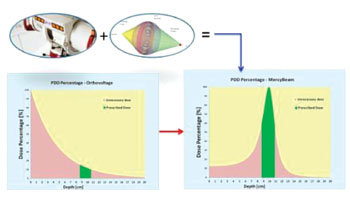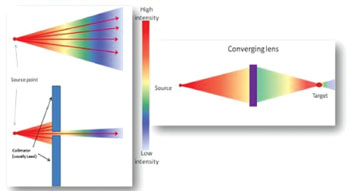Beam Technology Enables Less Harmful, More Accurate, and Cost-Effective Radiotherapy 
|
By MedImaging International staff writers Posted on 21 Apr 2014 |

Image: Schematic showing MercyBeam converging the orthovoltage X-ray (Photo courtesy of Convergent R.N.R.).

Image: Schematic showing collimation vs. convergence: MercyBeam provides more accurate coverage than any other technology (Photo courtesy of Convergent R.N.R.).
Newly developed technology will enable more effective, less harmful, and drastically less costly radiotherapy and radiosurgery treatment using low-energy X-ray tubes instead of high-energy sources typically used today.
Convergent R.N.R., Ltd. (CRnR; Tirat Carmel, Israel) has completed a very effective and promising proof-of-concept session of the Mercy Beam technology.
The Mercy Beam introduces an advanced lens that gathers most of the X-rays emanating divergently out of any traditional X-ray tube (currently used for X-ray imaging) and converges it towards the tumor site. The lens simultaneously removes low-energy photons that would be absorbed by the patient’s skin. The convergence increases the therapeutic dose delivered at the tumor target, while the organs in the vicinity of the tumor receive a very low dose or no dose at all. The converging technology enables the use of photon-energy X-rays 100 times lower than those used by current systems that are based on linear accelerators (LINACs). This technology, because of its low energy requirement, enables a small, light and inexpensive solution in which the cancer is treated accurately with a concentrated radiation at a fraction of the cost of all other methods.
“Today’s radiation treatment and surgery uses very high energy X-ray radiation that not only penetrates the body to reach the tumor, but also scatters towards the surrounding environment including healthy tissue, causing unwanted damage,” said Zeev Harel, CEO of CRnR. “To deal with such high energy X-rays, the protocol requires the machine installation inside a room of several feet of concrete walls, and heavy lead doors, which make those solutions even more expensive. Mercy Beam would revolutionize cancer treatment as we know it today, allowing many patients to receive a merciful, efficient and affordable treatment. The use of low energy X-rays will enable operating the system in standard X-ray rooms [no need for ‘special bunkers’] and in the future even in vans/lorries/trailers that may travel to remote areas. The technology is targeted for treating many types of cancerous tumors with an emphasis on treating of small children.”
Convergent R.N.R. (CRnR) is a medical start-up company developing a new X-ray focusing technology called MercyBeam to perform cancer radiotherapy and radiosurgery. CRnR developed and patented the said break-through technology utilizing a standard imaging X-ray source to form a converging beam into a volume of treatment instead of the conventional diverging or collimated technologies existing today.
Related Links:
Convergent R.N.R.
Mercy Beam
Convergent R.N.R., Ltd. (CRnR; Tirat Carmel, Israel) has completed a very effective and promising proof-of-concept session of the Mercy Beam technology.
The Mercy Beam introduces an advanced lens that gathers most of the X-rays emanating divergently out of any traditional X-ray tube (currently used for X-ray imaging) and converges it towards the tumor site. The lens simultaneously removes low-energy photons that would be absorbed by the patient’s skin. The convergence increases the therapeutic dose delivered at the tumor target, while the organs in the vicinity of the tumor receive a very low dose or no dose at all. The converging technology enables the use of photon-energy X-rays 100 times lower than those used by current systems that are based on linear accelerators (LINACs). This technology, because of its low energy requirement, enables a small, light and inexpensive solution in which the cancer is treated accurately with a concentrated radiation at a fraction of the cost of all other methods.
“Today’s radiation treatment and surgery uses very high energy X-ray radiation that not only penetrates the body to reach the tumor, but also scatters towards the surrounding environment including healthy tissue, causing unwanted damage,” said Zeev Harel, CEO of CRnR. “To deal with such high energy X-rays, the protocol requires the machine installation inside a room of several feet of concrete walls, and heavy lead doors, which make those solutions even more expensive. Mercy Beam would revolutionize cancer treatment as we know it today, allowing many patients to receive a merciful, efficient and affordable treatment. The use of low energy X-rays will enable operating the system in standard X-ray rooms [no need for ‘special bunkers’] and in the future even in vans/lorries/trailers that may travel to remote areas. The technology is targeted for treating many types of cancerous tumors with an emphasis on treating of small children.”
Convergent R.N.R. (CRnR) is a medical start-up company developing a new X-ray focusing technology called MercyBeam to perform cancer radiotherapy and radiosurgery. CRnR developed and patented the said break-through technology utilizing a standard imaging X-ray source to form a converging beam into a volume of treatment instead of the conventional diverging or collimated technologies existing today.
Related Links:
Convergent R.N.R.
Mercy Beam
Latest Radiography News
- World's Largest Class Single Crystal Diamond Radiation Detector Opens New Possibilities for Diagnostic Imaging
- AI-Powered Imaging Technique Shows Promise in Evaluating Patients for PCI
- Higher Chest X-Ray Usage Catches Lung Cancer Earlier and Improves Survival
- AI-Powered Mammograms Predict Cardiovascular Risk
- Generative AI Model Significantly Reduces Chest X-Ray Reading Time
- AI-Powered Mammography Screening Boosts Cancer Detection in Single-Reader Settings
- Photon Counting Detectors Promise Fast Color X-Ray Images
- AI Can Flag Mammograms for Supplemental MRI
- 3D CT Imaging from Single X-Ray Projection Reduces Radiation Exposure
- AI Method Accurately Predicts Breast Cancer Risk by Analyzing Multiple Mammograms
- Printable Organic X-Ray Sensors Could Transform Treatment for Cancer Patients
- Highly Sensitive, Foldable Detector to Make X-Rays Safer
- Novel Breast Cancer Screening Technology Could Offer Superior Alternative to Mammogram
- Artificial Intelligence Accurately Predicts Breast Cancer Years Before Diagnosis
- AI-Powered Chest X-Ray Detects Pulmonary Nodules Three Years Before Lung Cancer Symptoms
- AI Model Identifies Vertebral Compression Fractures in Chest Radiographs
Channels
MRI
view channel
AI Tool Predicts Relapse of Pediatric Brain Cancer from Brain MRI Scans
Many pediatric gliomas are treatable with surgery alone, but relapses can be catastrophic. Predicting which patients are at risk for recurrence remains challenging, leading to frequent follow-ups with... Read more
AI Tool Tracks Effectiveness of Multiple Sclerosis Treatments Using Brain MRI Scans
Multiple sclerosis (MS) is a condition in which the immune system attacks the brain and spinal cord, leading to impairments in movement, sensation, and cognition. Magnetic Resonance Imaging (MRI) markers... Read more
Ultra-Powerful MRI Scans Enable Life-Changing Surgery in Treatment-Resistant Epileptic Patients
Approximately 360,000 individuals in the UK suffer from focal epilepsy, a condition in which seizures spread from one part of the brain. Around a third of these patients experience persistent seizures... Read moreUltrasound
view channel.jpeg)
AI-Powered Lung Ultrasound Outperforms Human Experts in Tuberculosis Diagnosis
Despite global declines in tuberculosis (TB) rates in previous years, the incidence of TB rose by 4.6% from 2020 to 2023. Early screening and rapid diagnosis are essential elements of the World Health... Read more
AI Identifies Heart Valve Disease from Common Imaging Test
Tricuspid regurgitation is a condition where the heart's tricuspid valve does not close completely during contraction, leading to backward blood flow, which can result in heart failure. A new artificial... Read moreNuclear Medicine
view channel
Novel Radiolabeled Antibody Improves Diagnosis and Treatment of Solid Tumors
Interleukin-13 receptor α-2 (IL13Rα2) is a cell surface receptor commonly found in solid tumors such as glioblastoma, melanoma, and breast cancer. It is minimally expressed in normal tissues, making it... Read more
Novel PET Imaging Approach Offers Never-Before-Seen View of Neuroinflammation
COX-2, an enzyme that plays a key role in brain inflammation, can be significantly upregulated by inflammatory stimuli and neuroexcitation. Researchers suggest that COX-2 density in the brain could serve... Read moreGeneral/Advanced Imaging
view channel
AI-Powered Imaging System Improves Lung Cancer Diagnosis
Given the need to detect lung cancer at earlier stages, there is an increasing need for a definitive diagnostic pathway for patients with suspicious pulmonary nodules. However, obtaining tissue samples... Read more
AI Model Significantly Enhances Low-Dose CT Capabilities
Lung cancer remains one of the most challenging diseases, making early diagnosis vital for effective treatment. Fortunately, advancements in artificial intelligence (AI) are revolutionizing lung cancer... Read moreImaging IT
view channel
New Google Cloud Medical Imaging Suite Makes Imaging Healthcare Data More Accessible
Medical imaging is a critical tool used to diagnose patients, and there are billions of medical images scanned globally each year. Imaging data accounts for about 90% of all healthcare data1 and, until... Read more
Global AI in Medical Diagnostics Market to Be Driven by Demand for Image Recognition in Radiology
The global artificial intelligence (AI) in medical diagnostics market is expanding with early disease detection being one of its key applications and image recognition becoming a compelling consumer proposition... Read moreIndustry News
view channel
GE HealthCare and NVIDIA Collaboration to Reimagine Diagnostic Imaging
GE HealthCare (Chicago, IL, USA) has entered into a collaboration with NVIDIA (Santa Clara, CA, USA), expanding the existing relationship between the two companies to focus on pioneering innovation in... Read more
Patient-Specific 3D-Printed Phantoms Transform CT Imaging
New research has highlighted how anatomically precise, patient-specific 3D-printed phantoms are proving to be scalable, cost-effective, and efficient tools in the development of new CT scan algorithms... Read more
Siemens and Sectra Collaborate on Enhancing Radiology Workflows
Siemens Healthineers (Forchheim, Germany) and Sectra (Linköping, Sweden) have entered into a collaboration aimed at enhancing radiologists' diagnostic capabilities and, in turn, improving patient care... Read more



















